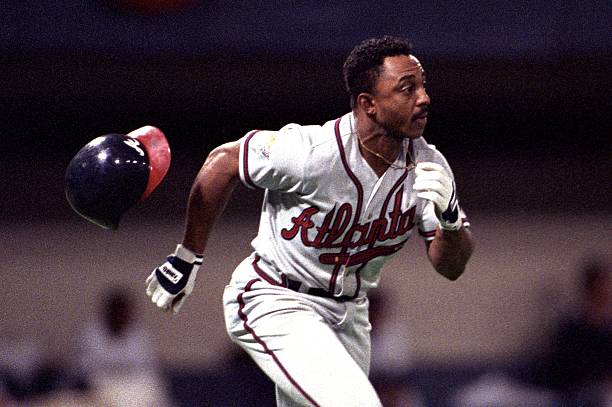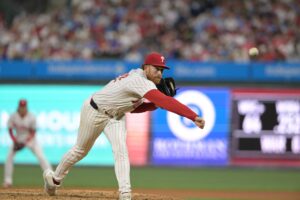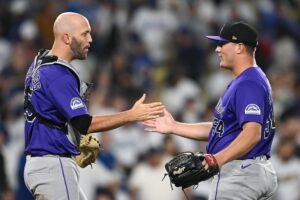Lonnie Smith was never the world’s greatest baseball player, though there were times when he could have been in the upper echelon. His speed was his greatest quality, as he swiped 370 bags during his 17-year career. He was above average with the bat, putting up a career average of .288, a tad over 1,400 hits, and 273 doubles. Other than that, nothing truly lifts off of his stat sheet. No one number raises a clear indicator of how good Smith could be. At the heart of his career numbers lies a journeyman with excellent legs. However, there is one year that is not like the others.
We begin a new series today examining the five best offensive seasons in Atlanta Braves history. It starts with Smith, the unlikeliest of progenitors, making his mark on a team that failed in many ways. The 1989 Braves were coming to the end of their era of cellar dwelling, though nobody knew it. Certain things were beginning to turn, and a new future was dawning. In an individual reflection, Lonnie Smith had his best season ever. A rough patch in his career turned into one of the most intriguing stories in team history. It now ranks as the fifth best offensive Braves season by WAR according to Baseball Reference.
Lonnie Smith’s Rough Patch
If Lonnie Smith was looking for anything entering 1989, it was consistent playing time. He’d only been involved in 91 contests over the previous two seasons. A lot of this had to do with his involvement in the events surrounding baseball’s cocaine scandals. After 1987, the Kansas City Royals had released Smith, despite him picking up 42 hits in 48 games. The Braves signed him and he hit a modest .237 in 43 games during 1988. Things may have looked rather bleak for the veteran left fielder, but he was about to have a breakthrough.
April: Lonnie Smith Breaks Out
It certainly did not begin this way, as he didn’t record a single hit in his first 11 at-bats. He exploded after he picked up his first knock. Over a seven game hitting streak, he went 12-for-29 (.414) with three homers and seven RBI. Overall, in the month of April, he hit .326 with 30 hits, five doubles, a triple, nine stolen bases, and 18 walks. The free passes may be the most telling out of all of his statistics. The season saw him play a much more patient form of baseball. His walk percentage went from 8.0% in 1988 to 13.2% in 1989. April was just the beginning, as he went on to have consistent free pass numbers all throughout the season.
May & June: Consistency Amidst Inconsistency
In May, Smith provided more steady offense for a Braves team in desperate need of it. He hit .321 with three more homers, eight more RBI, and 13 more walks. In addition, he slugged .642 and posted his first month with an OPS north of 1.000. He was so good, in fact, that it shot up to 1.104. Unfortunately, an injury caused him to miss a good chunk of the end of the month. That said, upon his return, his bat continued to put torches to shame. He hit .328 in the month of June with four homers, ten RBI, and 19 hits. His contact was impeccable, finding ways to get on base in lieu of striking out. His walks naturally suffered as a result, however he only struck out six times all month. Wood found the ball, and Smith found his spot as one of the best players on the Braves’ roster.
July: Lonnie Smith Catches Fire
In July, while the Braves struggled to an 11–16 record, Lonnie Smith exploded. He crushed the ball to the tune of a .344 average and 33 hits. There were only seven games all month long where he did not get on base safely. His power was elite as well, hitting six homers and four doubles. By comparison, league MVP Kevin Mitchell, who launched 47 homers, only had two more in the entire month. Considering the return to consistency, Smith also found his patience once more. His 18 walks helped contribute to an on-base percentage of .448 and a blistering OPS of 1.042. In total, Smith’s contributions to the Braves added a win probability of 2.066. So, again, while the team was struggling overall, Smith had broken free in a big way.
August: A Cooling Period
In August, Smith cooled a little bit. That said, his numbers on a so-called cold streak are enviable. He still hit .305 for the month with 32 hits and an impressive 12 doubles. His power dimmed a bit (three homers in 105 at-bats). That said, he still managed 12 walks and drove in 17 runs. He hit a bit of a skid in the middle of the month where he had one hit in a seven game stretch. However, during the final 12 games, he only went hitless once. During this span, he hit a scalding .391 (18-for-46) with 11 RBI, taking a six game hitting streak into September.
September: Weaknesses Show
September was Smith’s weakest month as the Braves sputtered to a 9–14 mark. He hit .269 with two homers. His strikeout numbers were meteoric, skyrocketing to 25 in 78 at-bats. However, he continued to drive in his fair share of runs, posting 15 RBI. An interesting aspect of this month is the sheer difference between Smith’s average and his BABIP. The latter statistic sits at a hefty .352. So, a great deal of blame for his comparatively slow offense in this month definitely lies with his whiff rate. He struck out over 26% of the time, yet still managed a respectable wRC+ of 112. That’s how good Smith was in 1989.
Lonnie Smith: Unlikely Hero
Overall, Lonnie Smith posted an 8.8 WAR during this season, the best in the National League. His .415 on-base mark was also tops. He hit .315 with 21 homers and 79 RBI, finishing 11th in MVP voting. An OPS of .948 was good for third in the league and an OPS+ of 168 was fourth. He created 113 runs, beating out the likes of Ryne Sandberg, Bobby Bonilla, and Tony Gwynn. In addition, he swatted 59 extra base hits, placing him in the top-ten in the league. To sum it all up, one of the unlikeliest players kept company with some of the best bats of the day. The fact that he did it after overcoming so many obstacles only makes it worth repeating.
Main Photo:
Embed from Getty Images
Players Mentioned:
Lonnie Smith, Kevin Mitchell, Ryne Sandberg, Bobby Bonilla, Tony Gwynn






